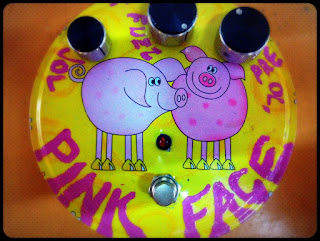 |
| The Caribass - ROG Flipster |
This time we are off and away from the world of guitar and into the bass we dive deep.
Runoffgroove's (ROG) Flipster was designed to emulate the tone and drive of the famous Ampeg Portaflex SB-12 bass amp. This amp was the little brother in a series of tube amps designed in the mid 60's. The amp had a 12'' Jenson speaker cabinet and was probably used on many recordings from 1965 and on through the 70's. Mo-Town Bass sound was known for using Ampeg bass amps.
I don't know too much about bass amps but I do know that I like Ampeg bass amps. They are smooth and have a lot of bottom as well as edge. I particularly love controlling the character of a song using bass, whether it's deep dub style lo-pass or grungy-rock overdriven tone. When I play bass I sometimes like to switch quickly between styles and all that flexibility means I need a good pedal, capable of drive range from clean to hard drive with some equalizing options.
I don't know too much about bass amps but I do know that I like Ampeg bass amps. They are smooth and have a lot of bottom as well as edge. I particularly love controlling the character of a song using bass, whether it's deep dub style lo-pass or grungy-rock overdriven tone. When I play bass I sometimes like to switch quickly between styles and all that flexibility means I need a good pedal, capable of drive range from clean to hard drive with some equalizing options.
 |
| A 1965 Portaflex SB-12 |
I played with the pedal on more than a few occasions and I still use it more for live than in the studio. It gives you the ability to drive your bass without touching the amp and it's not like an overdrive pedal which cuts the lows. You can maintain your lows and still bark and bite. For really hard bass distortion there is nothing better then the Pro-co Rat or any version of it like my Bat shown here on a previous post.
There is a new Portaflex SB-12 version now called "Ginger" which is supposed to be better. I think I know what they are talking about, The Flipster was good, but not so much as an emulation of the Ampeg amp. I did have problems getting low gain clean tones with the Flipster but it was good for what I needed.
Because I got an interesting paint job on the wooden enclosure which had some Carribean touch to it I decided to call the pedal Caribass. With my Music-Man Sting Ray replica bass I can get some great tones with almost any style.
I am definitely getting ready to upgrade the Flipster to the Ginger. Stay tuned as it is right around the corner.
If you want gut shots or audio clips just comment and I'll add them. As always, schematic is available here. More info from Runoffgroove can be found here.















.JPG)


.jpg)
.jpg)
.jpg)
.jpg)







